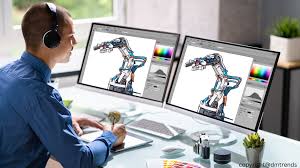
The Art of Web Graphic Design
Web graphic design is a crucial aspect of creating visually appealing and engaging websites. It involves the use of images, colors, typography, and other visual elements to communicate messages effectively and enhance the user experience.
Good web graphic design goes beyond just making a website look pretty; it also plays a significant role in building brand identity and conveying the right message to the target audience. Whether it’s creating eye-catching banners, designing intuitive navigation menus, or selecting the perfect color scheme, every element of web graphic design contributes to the overall success of a website.
One key principle of web graphic design is consistency. Consistent use of colors, fonts, and imagery helps create a cohesive look and feel across all pages of a website, reinforcing brand recognition and making it easier for users to navigate and interact with the site.
Another important aspect of web graphic design is responsiveness. With the increasing use of mobile devices to access websites, designers must ensure that graphics are optimized for different screen sizes and resolutions. This requires careful consideration of image sizes, placement, and scaling to maintain visual appeal across various devices.
In addition to aesthetics, web graphic design also plays a role in user engagement and conversion rates. Well-designed graphics can help draw attention to important content, guide users through the site’s structure, and encourage them to take desired actions such as making a purchase or signing up for a newsletter.
In conclusion, web graphic design is an essential component of successful website development. By paying attention to details such as layout, color scheme, typography, and imagery, designers can create visually stunning websites that not only look great but also function effectively to meet the needs of both businesses and their target audiences.
5 Essential Web Graphic Design Tips for Enhanced User Experience and Performance
- Keep your design simple and clean for better user experience.
- Choose a consistent color scheme and font style to maintain visual harmony.
- Optimize images for web to ensure fast loading times.
- Use whitespace effectively to improve readability and focus on key elements.
- Ensure your design is responsive to different screen sizes for optimal viewing on all devices.
Keep your design simple and clean for better user experience.
Keeping your web graphic design simple and clean is a key tip for enhancing the user experience. By minimizing clutter, using a clear layout, and focusing on essential elements, you can create a visually appealing website that is easy to navigate and understand. A simple and clean design helps users quickly find the information they need, improves readability, and reduces distractions, ultimately leading to a more enjoyable and effective interaction with your website.
Choose a consistent color scheme and font style to maintain visual harmony.
When it comes to web graphic design, selecting a consistent color scheme and font style is crucial for maintaining visual harmony across a website. By choosing colors that complement each other and a font style that aligns with the overall aesthetic, designers can create a cohesive and professional look that enhances the user experience. Consistency in color and typography not only improves readability but also reinforces brand identity and helps establish a strong visual presence that resonates with visitors.
Optimize images for web to ensure fast loading times.
Optimizing images for the web is a crucial tip in web graphic design to ensure fast loading times and enhance user experience. By reducing file sizes through compression without compromising quality, web designers can significantly improve a website’s performance. This optimization not only helps pages load faster but also contributes to better SEO rankings and overall user satisfaction. Prioritizing image optimization is a simple yet effective way to make a website more efficient and user-friendly, ultimately leading to higher engagement and conversion rates.
Use whitespace effectively to improve readability and focus on key elements.
Effective use of whitespace is a fundamental principle in web graphic design that can significantly enhance readability and draw attention to key elements on a webpage. By strategically incorporating ample whitespace around text, images, and other content, designers can create a visually balanced layout that allows the eyes to rest and the important information to stand out. Whitespace helps improve the overall user experience by making content easier to read and understand, guiding users’ focus towards essential elements, and creating a sense of organization and clarity on the page.
Ensure your design is responsive to different screen sizes for optimal viewing on all devices.
It is crucial to ensure that your web graphic design is responsive to different screen sizes to provide optimal viewing on all devices. By designing with responsiveness in mind, you can create a seamless user experience across desktops, laptops, tablets, and smartphones. This approach not only enhances usability but also improves accessibility and engagement for visitors accessing your website from various devices. Responsive design allows your graphics to adapt fluidly to different screen sizes, ensuring that your content remains visually appealing and easy to navigate regardless of the device being used.
